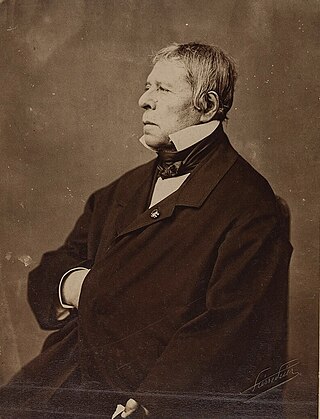
Jean-Auguste-Dominique Ingres was a French Neoclassical painter. Ingres was profoundly influenced by past artistic traditions and aspired to become the guardian of academic orthodoxy against the ascendant Romantic style. Although he considered himself a painter of history in the tradition of Nicolas Poussin and Jacques-Louis David, it is his portraits, both painted and drawn, that are recognized as his greatest legacy. His expressive distortions of form and space made him an important precursor of modern art, influencing Picasso, Matisse and other modernists.
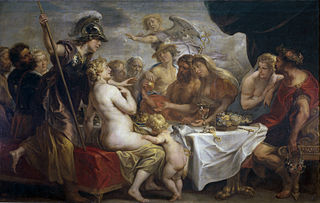
A figure painting is a work of fine art in any of the painting media with the primary subject being the human figure, whether clothed or nude. Figure painting may also refer to the activity of creating such a work. The human figure has been one of the constant subjects of art since the first Stone Age cave paintings, and has been reinterpreted in various styles throughout history.

Merry-Joseph Blondel was a French history painter of the Neoclassical school. He was a winner of the prestigious Prix de Rome in 1803. After the salon of 1824, he was bestowed with the rank of Knight in the order of the Legion d'Honneur by Charles X of France and offered a professorship at the École nationale supérieure des Beaux-Arts: a position in which he remained until his death in 1853. In 1832, he was elected to a seat at the Académie des Beaux-Arts in Paris.

Napoleon I on his Imperial Throne is an 1806 portrait of Napoleon I of France in his coronation costume, painted by the French painter Jean-Auguste-Dominique Ingres.

Madame Moitessier is a portrait of Marie-Clotilde-Inès Moitessier begun in 1844 and completed in 1856 by Jean-Auguste-Dominique Ingres. The portrait, which depicts Madame Moitessier seated, is now in the collection of the National Gallery in London, which acquired it in 1936.

Portrait of Monsieur Bertin is an 1832 oil on canvas painting by Jean-Auguste-Dominique Ingres. It depicts Louis-François Bertin (1766–1841), the French writer, art collector and director of the pro-royalist Journal des débats. Ingres completed the portrait during his first period of success; having achieved acclaim as a history painter, he accepted portrait commissions with reluctance, regarding them as a distraction from more important work. Bertin was a friend and a politically active member of the French upper-middle class. Ingres presents him as a personification of the commercially minded leaders of the liberal reign of Louis Philippe I. He is physically imposing and self-assured, but his real-life personality shines through – warm, wry and engaging to those who had earned his trust.

The Turkish Bath is an oil painting by Jean-Auguste-Dominique Ingres, initially completed between 1852 and 1859, but modified in 1862. The painting depicts a group of nude women at a pool in a harem. It has an erotic style that evokes both the Near East and earlier western styles associated with mythological subject matter. The painting expands on a number of motifs that Ingres had explored in earlier paintings, in particular The Valpinçon Bather (1808) and La Grande odalisque (1814) and is an example of Romanticism.

The Apotheosis of Homer is a grand 1827 painting by the French Neoclassical artist Jean-Auguste-Dominique Ingres, now exhibited at the Louvre as INV 5417. The symmetrical composition depicts Homer being crowned by a winged figure personifying Victory or the Universe. Forty-four additional figures pay homage to the poet in a kind of classical confession of faith.
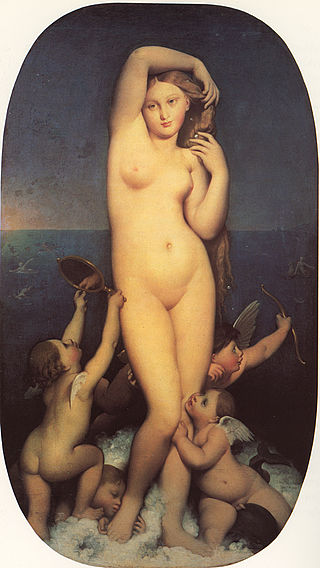
Venus Anadyomene is a painting by the French painter Jean-Auguste-Dominique Ingres. It is now held at the Musée Condé, Chantilly, France. It is a female nude of the Venus Anadyomene type, showing the goddess Venus rising from the sea.

The Ambassadors of Agamemnon in the tent of Achilles is an oil-on-canvas painting by Jean-Auguste-Dominique Ingres, produced in 1801 for the Prix de Rome competition. It is now in the École nationale supérieure des beaux-arts in Paris.

Don Pedro of Toledo Kissing Henry IV's Sword was originally a painting of 1814 in the Troubador style by the French artist Jean-Auguste-Dominique Ingres, showing the Spanish ambassador Pedro Álvarez de Toledo, 5th Marquis of Villafranca kissing the sword of Henry IV of France in the salle des Caryatides of the Louvre Palace. The 1814 painting is now lost. Between 1819 and 1832, Ingres painted three additional versions of the subject.

The Martyrdom of Saint Symphorian is an 1834 painting by the French artist Jean-Auguste-Dominique Ingres. It shows the death of Saint Symphorian, the first Christian martyr in Gaul. Painted in oil on canvas and measuring 407 x 339 cm, it is now in Autun Cathedral. Although Ingres considered the painting—completed only after ten years of diligent work—one of his crowning achievements, it was criticized harshly when he exhibited it in the Paris Salon of 1834. It subsequently has been considered emblematic of Ingres' misguided ambition to excel as a history painter.
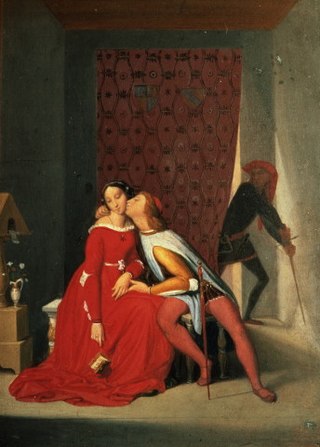
Paolo and Francesca is an oil painting on canvas by the French artist Jean-Auguste-Dominique Ingres, produced in seven known versions between 1814 and 1850. It derives from the story of Paolo and Francesca in Dante's Inferno. With Ingres' The Engagement of Raphael, these works represent early examples of the troubador style.
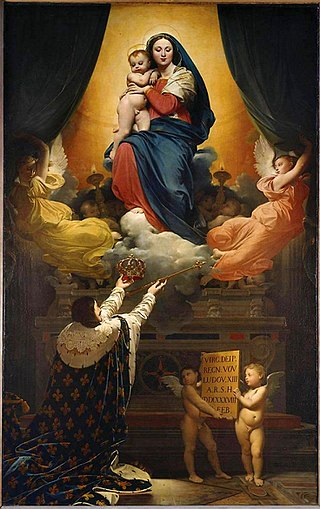
The Vow of Louis XIII is an 1824 oil painting on canvas by the French Neoclassical artist Jean-Auguste-Dominique Ingres, now in Montauban Cathedral. The painting depicts a vow to the Virgin Mary by Louis XIII of France.

Roger Freeing Angelica or Ruggiero Freeing Angelica is an 1819 painting by the French artist Jean-Auguste-Dominique Ingres, inspired by Orlando Furioso by Ariosto. An oil painting on canvas measuring 147 x 199 cm, it is owned by the Louvre. Ingres subsequently painted several variants of the composition.

The Portrait of Comtesse d'Haussonville is an 1845 oil-on-canvas painting by the French Neoclassical artist Jean-Auguste-Dominique Ingres.

Portrait of Marie-Françoise Rivière is a c. 1805 oil-on-canvas painting by the French Neoclassical artist Jean-Auguste-Dominique Ingres.

Portrait of Caroline Murat, Queen of Naples is an 1814 oil on canvas painting by the French Neoclassical artist Jean-Auguste-Dominique Ingres. Caroline Murat, née Bonaparte, was the sister of Napoleon, and married Joachim Murat, a Marshal of France and Admiral of France, and later King of Naples. Caroline commissioned the portrait as part of an effort to convey her standing and worth to reign as Queen of Naples during an unstable political climate.

Virgil reading the Aeneid before Augustus, Livia and Octavia, known in French as Tu Marcellus Eris, is an 1812 painting by Jean-Auguste-Dominique Ingres. It is an oil on canvas measuring 304 x 323 cm and is in the Musée des Augustins in Toulouse. It depicts the moment when Virgil, reciting his work to the Emperor Augustus, his wife Livia and his sister Octavia, mentions the name of Octavia's dead son, Marcellus, causing Octavia to faint. Augustus' advisors, Marcus Agrippa and Gaius Maecenas, can be seen watching in the background. The painting is based on an anecdote, recorded in the late fourth-century vita of Virgil by Aelius Donatus, in which the poet read the passage in Book VI in praise of Octavia's late son Marcellus, and Octavia fainted with grief. This anecdote has also been depicted in works by other artists, including Jean-Joseph Taillasson, Antonio Zucchi, Jean-Baptiste Wicar, Jean-Bruno Gassies and Angelica Kaufmann.

Luigi Cherubini and the Muse of Lyric Poetry is an 1842 oil-on-canvas allegorical portrait of Luigi Cherubini by Jean-Auguste-Dominique Ingres and his then-pupil Henri Lehmann. It was bought from Ingres for 8,000 francs by Louis-Philippe I using civil list money in June 1842 and given to the musée du Luxembourg, before being moved in 1874 to the Louvre Museum, in whose collections it still resides.






















